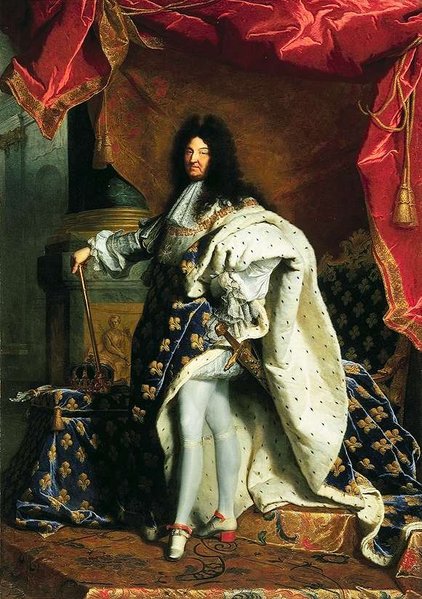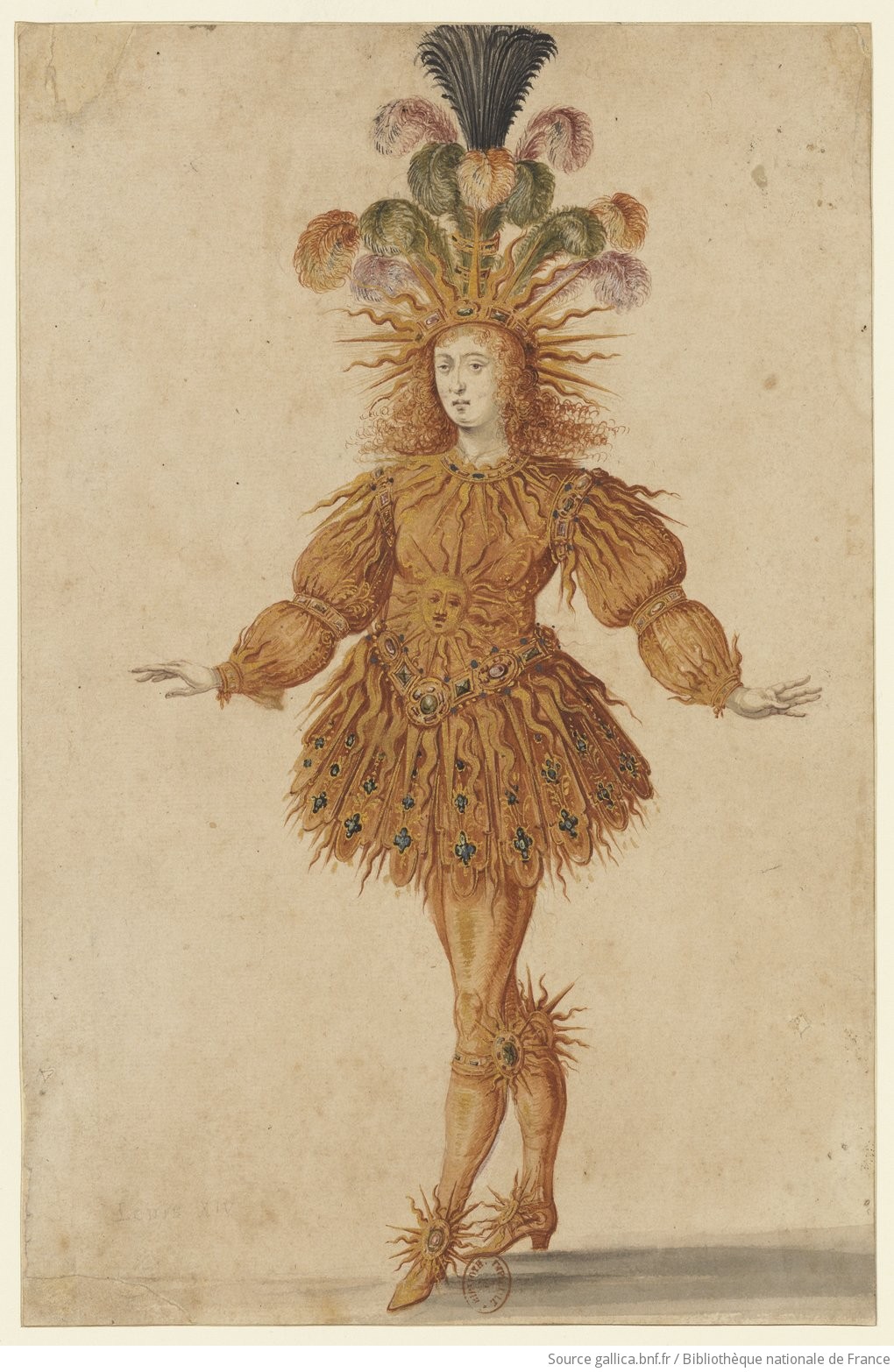If one knows anything at all about the history of classical
ballet, one knows that it began, more or less, with the court dances of the
Ancien Régime, in France. In particular, Louis XIV, the brilliant young “Sun
King” while a still a teenager raised the art form from polite entertainment to
a shock-and-awe spectacle that made manifest his divine election. In 1653, at
the connivance of his Italian chief minister, Cardinal Mazarin, he appeared in
a suite of dances called Le Ballet de la
Nuit, with music by Lully, culminating (as the night generally does) with
the break of day, when the king, dressed in golden armor of the Roman style and
sporting a corona of golden rays, “rose” from beneath the dancing floor, in the
persona of Apollo.
Gérard Corbiau’s film, Le roi danse, from 2000 is hard to get hold of in the US, but you can at least watch his reconstruction of the thrilling moment on
YouTube: https://www.youtube.com/watch?v=BMvpvDjFvHA.
Aside from the slight whiff of fromage
it provides quite a convincing picture of how impressive this apotheosis would
have been.
 |
| Vaux-le-Vicomte: a pocket Versailles (for those with deep pockets) |
And Louis took dance very seriously; in 1661 he actually arrested
(and subsequently imprisoned for life) his finance minister, in part because of
a ballet. Nicolas Fouquet had commissioned a work from
the great dramatist Molière, Les Fâcheux (“The
Unfortunates” or "The Annoying Ones" – a cruelly apt title given what became of its patron). It was
performed on a hot August evening in the gardens of his magnificent castle at
Vaux-le-Vicomte, and tout le monde attended.
The King was the guest of honor. He applauded Molière’s accomplishment, but he was
not amused by the pretense of his CFO. Fouquet had dared to rival the king as a
patron of both architecture and ballet – the means by which Louis perceived his
divine prerogative should be made manifest.
But why dance? It all has to do with power and message. The
dancer’s body speaks persuasively, viscerally, and that means that whatever
message it conveys exercises persuasive force. An absolute monarch absolutely
must control the messages that bodies in motion express. Mark Franko, a dance
historian, writes, “In 1661, court ballet was still a vast metaphor for social
interaction. In order to exert control over the medium of dance, which was
indirectly a control over his courtiers, he (Louis) institutionalized dance by
founding a Royal Academy of Dancing.” [Franko, 2015].
 |
| He's got legs and he knows how to use them. |
Louis was the Dancing King, and the King of
Dance as well (and he had the gams to prove it, as his famous portrait by
Hycinthe Rigaud shows). Ballet would not be the same without him. But he was
not the only monarch to stake his power on dance performance.
Today I went to Dumbarton Oaks, a small
museum that specializes in Byzantine and Pre-Columbian art. The collection was
assembled by Robert Woods Bliss and Mildred Barnes Bliss, a wealthy diplomatic couple,
who gave their house (which they had designed with an eye to its future
existence as a museum), collections, and gardens to Harvard University in 1940
as “a home for the humanities.” It is a little corner of Paradise in
Georgetown.
 |
| The Johnson Pavilion |
After spending a very long time ogling the
exquisite objects in the Byzantine collection (oh, the jewelry!), I wandered
into the new part of the building (the original house is a Federal-style brick
mansion); this addition was built by Philip Johnson in the early 1960s, and it
is, in true Johnson fashion, more glass and light and air than anything else.
It takes the form of a ring of domed pavilions encircling a simple fountain. I
overheard a woman saying, “Ah, still more beauty!” as she looked about.
In the pavilion dedicated to the Maya, I
eavesdropped while an erudite man explained to his companion the differences
between alphabets, syllabaries, and ideographic systems. It turns out that when
paleographers are trying to decipher an ancient form of writing, they use basic
statistical analysis to begin to understand whether they’re looking at an
alphabetical system in which each character corresponds to a single sound, a
syllabary, in which character represents a syllable (consonant/vowel grouping),
or a pictographic or ideographic system, in which the characters represent
whole words. It turns out (according to Mr. Smarty Pants, who sounded pretty
credible to me) that if there are about 20-40 frequently repeated characters,
you are looking at an alphabet, 40-70, a syllabary, and over 70, usually over
100, an ideographic system.
When he had moved on I walked over to see
what had prompted his little disquisition; and it was a limestone panel, about
six feet tall, dense, yes, with Mayan glyphs (which are a combination of
logograms and syllabic characters, as it happens). But at the center, almost
life size, stands a figure. Or rather, not stands, but dances. His body faces
front, though he turns his head sharply to the left, so his face appears in
full profile.
 |
| For a zoomable hi-res image go here |
Young, lithe, and slim as any Greek kouros,
he also shares their suspension between aristocratic detachment and action.
He
lifts one heel off the ground, cocking his knee and raising his hip and
shoulder on that side. His corresponding arm also rises, his elbow just a
little lower than his shoulder, his hand held up at the height of his head, his
fingers curled around the slender, serpentine handle of his very nasty looking
axe (I had just been checking out the evil-yet-beautiful jade axe blades in the
neighboring vitrine). On the other side, he holds his hand low, by his hip, and
in it he clutches some kind of handled pot and a docile-looking viper.
According to the museum’s wall label, this little bucket is labeled “darkness”
and symbolizes a massive, light-killing thunderstorm.
The glyphs give us his name – K’an Joy Chitam – and inform those who
can read them that here he performs a dance in which he becomes Chaak, the
Mayan god of bad weather and blood sacrifice. His parents kneel to either side
of him, as the panel has some kind of genealogical significance.
He wears an elaborate costume. His head-dress,
ear-ornaments, necklace, and pectoral seem to be made up of serpents’ coils,
turtle shells, and beads. He wears cuffs with inlaid patterns that look a great
deal like the flashy golden arm-rings embedded with precious stones that I saw
in a case a few yards away. Then he has this pleated kilt of sorts,
high-waisted, falling just to the tops of his thighs, and close fitting, showing
off the trim line of his waist and the swell of his thigh muscles. Over this he
wears a belt with two enormous strap-work bosses over the hips and a long,
long, sash hanging down right in the center, pinched between two enormous beads
between his thighs, and then descending to the space between his ankles in
their striated cuffs.
I would guess that originally the panel belonged to some
tomb or temple complex built in honor of this short-lived king, and that it
would have been painted brightly (I’ve watched my share of documentaries on
Nova); but even isolated and bare, it conveys a sense of this muscular, lithe,
young deity in human form, using his rigorously disciplined body to bridge the
gap between this world and that of the gods.
Dance, like other art
forms, is instrumental; that is, it enacts, rather than just relates,
knowledge, states of being, and power.
Matthew Looper explains the function of dance in rituals of kingship in
the Classic Maya world thus, “Such displays did not merely represent rulers’
control over divine forces, but actualized this power, making it real through
aesthetically grounded experience” (Looper, 2009).
That the human brain has some intrinsic aesthetic capability,
similar and perhaps related to the capability for spoken language, has emerged
from recent neuroscientific research, so that perhaps now people will begin to
take seriously what humanists have been insisting ever since Kant (at least),
namely that aesthetic experience is substantive, real and powerful. Although I
cringe at any universalizing theory that seeks to put all humanity in one tidy
explanatory box, I would like to think that K’an Joy Chitam and Louis XIV would
have recognized themselves in one another despite the vast gulf of time, space,
and culture between them. For both, the body of the king in all its youthful
virility, its splendidly costumed pomp, its skillful, technical command of
precise movement, made real and present their special relationship to their
respective deities.

Perhaps Merce Cunningham said it best: “If a dancer dances –
which is not the same as having theories about dancing or wishing to dance or
trying to dance or remembering in his body someone else’s dance – but if the
dancer dances, everything is there. . . Our ecstasy in dance comes from the possible
gift of freedom, the exhilarating moment that this exposing of the bare energy
can give us. What is meant is not license, but freedom.” So maybe that is why the king must lead the dance... otherwise, people might think that freedom belongs to them!
To read more about the Dumbarton Oaks dancer:
Matthew Looper, To Be
Like Gods: Dance in Ancient Maya Civilization, University of Texas Press,
2009
For more on Louis XIV and ballet:
Jennifer Homans, Apollo’s
Angels: A History of Ballet, Random House, 2011
Mark Franko, Dance as
Text: Ideologies of the Baroque Body, Oxford University Press, 2015

No comments:
Post a Comment